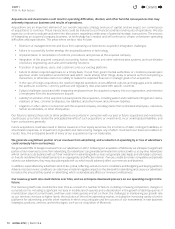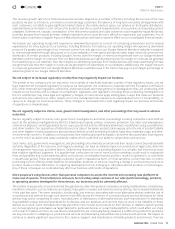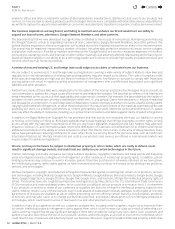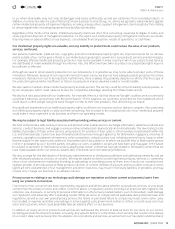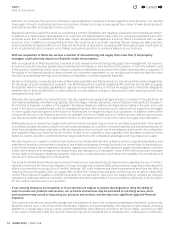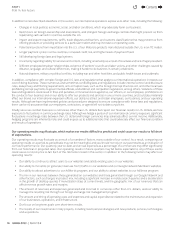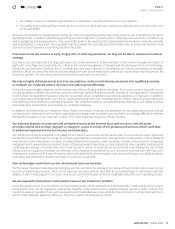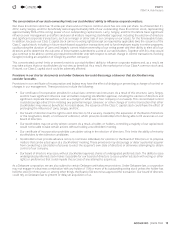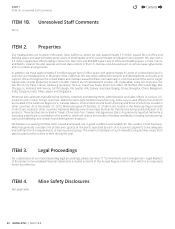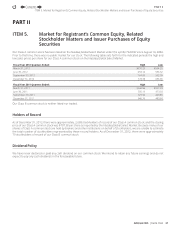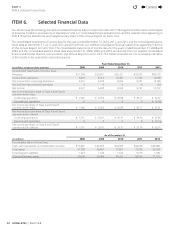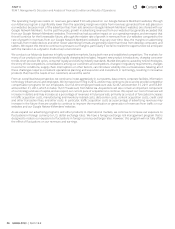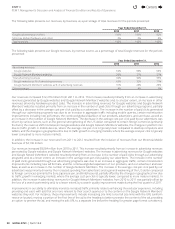Google 2012 Annual Report Download - page 24
Download and view the complete annual report
Please find page 24 of the 2012 Google annual report below. You can navigate through the pages in the report by either clicking on the pages listed below, or by using the keyword search tool below to find specific information within the annual report.
18 GOOGLE INC. | Form10-K
PART I
ITEM1A.Risk Factors
We may have exposure to greater thananticipated tax liabilities.
Our future income taxes could be adversely aff ected by earnings being lower than anticipated in jurisdictions that have lower
statutory tax rates and higher than anticipated in jurisdictions that have higher statutory tax rates, by changes in the valuation of
our deferred tax assets and liabilities, as a result of gains on our foreign exchange risk management program, or changes in tax
laws, regulations, or accounting principles, as well as certain discrete items. We are subject to regular review and audit by both
domestic and foreign tax authorities. Any adverse outcome of such a review or audit could have a negative eff ect on our operating
results and fi nancial condition. In addition, the determination of our worldwide provision for income taxes and other tax liabilities
requires signifi cant judgment, and there are many transactions and calculations where the ultimate tax determination is uncertain.
Although we believe our estimates are reasonable, the ultimate tax outcome may diff er from the amounts recorded in our fi nancial
statements and may materially aff ect our fi nancial results in the period or periods for which such determination is made.
Risks Related to Ownership of Our Stock
The trading price for our ClassA common stock may continue to be volatile, and if the shares of the new class of non-
voting Class C capital stock are distributed as expected, the trading price of that class may also be volatile and may
aff ect the trading price for the ClassA common stock.
The trading price of our ClassA common stock has at times experienced substantial price volatility and may continue to be
volatile. For example, from January1, 2012 through December31, 2012, the closing price of our ClassA common stock ranged
from $559.05 per share to $768.05 per share. The trading price of our ClassA common stock may fl uctuate widely in response
to various factors, some of which are beyond our control. These factors include, among others:
•Quarterly variations in our results of operations or those of our competitors.
•
Announcements by us or our competitors of acquisitions, new products, signifi cant contracts, commercial relationships,
or capital commitments.
•Recommendations by securities analysts or changes in earnings estimates.
•
Announcements about our earnings that are not in line with analyst expectations, the risk of which is enhanced because
it is our policy not to give guidance on earnings.
•Announcements by our competitors of their earnings that are not in line with analyst expectations.
•
Commentary by industry and market professionals about our products, strategies, and other matters aff ecting our business
and results, regardless of its accuracy.
•The volume of shares of ClassA common stock available for public sale.
•
Sales of ClassA common stock by us or by our stockholders (including sales by our directors, executive o cers, and other
employees).
•
Short sales, hedging, and other derivative transactions on shares of our ClassA common stock (including derivative
transactions under our Transferable Stock Option program).
In addition, we have announced the intention of our board of directors to consider a distribution of shares of our non-voting
Class C capital stock as a dividend to our holders of ClassA and Class B common stock, pending resolution of litigation involving
the authorization of that class.
Although we plan to list the Class C capital stock on The Nasdaq Stock Market, we cannot predict whether, or to what extent, a
liquid trading market will develop for the Class C capital stock. If it does not or if the Class C capital stock is not attractive to targets
as an acquisition currency or to our employees as an incentive, we may not achieve our objectives in creating this new class. As
in the case of the ClassA common stock, the trading price for the Class C capital stock may also be volatile and aff ected by the
factors noted above, as well as by the diff erence in voting rights as between the ClassA common stock and the Class C capital
stock, the volume of Class C capital stock available for public sale and sales by us and our stockholders of Class C capital stock,
including by institutional investors that may be unwilling, unable or choose not to hold non-voting shares they receive as part of
the stock dividend, if it is declared and paid. Whether or not the Class C capital stock is included in stock indices in the future may
also aff ect the trading prices of the ClassA common stock and the Class C capital stock.
In addition, the stock market in general, and the market for technology companies in particular, have experienced extreme price
and volume fl uctuations that have often been unrelated or disproportionate to the operating performance of those companies.
These broad market and industry factors may harm the market price of our ClassA common stock, and, if issued, our Class C
capital Stock, regardless of our actual operating performance.
Contents
44




